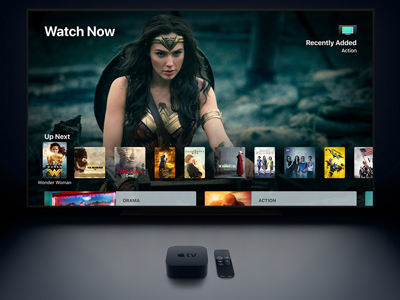
September is always a busy month for Apple, and this year is no different with all but one of the new products the company announced on Tuesday available at retail before the end of the month.
We’ve been waiting for Apple TV to catch up to the 4K/Ultra HD competition, including Roku’s Premiere+ and Ultra, Chromecast’s Ultra, and the myriad 4K Android TV products such as the Mi Box. Sooner rather than later, we’ll most likely see a new Amazon 4K Fire TV line as well as updates from Roku.
The world of streaming services has progressed enormously since the current fourth-gen Apple TV was released just short of two years ago. Yes, the tvOS has been updated to the current 10.2.2 for Gen-4 with the Apple TV app as its core. However, without 4K and HDR, something new was needed. With retail availability on Sept. 22, you’ll soon be able to have it.
Apple TV 4K will, as the name puts forward, offer 4K streaming (there was no mention of Ultra HD throughout the presentations). Pushing the bar further, it joins the Chromecast Ultra as the only streaming device with Dolby Vision. Ohers such as Roku and Android TV boxes only offer HDR10. To be sure, this is a major card in Apple’s deck, as high dynamic range is as important — some would say more important — to increased video quality as the added resolution. From a standards perspective, the Apple TV 4K also has the HEVC decoding, HDMI 2.0a and HDCP 2.2 standards under its belt, as the formats require.
For the integrator, the new model poses few challenges. The new unit is the same size as the current model. The rear panel is virtually identical, other than the deletion of the USB-C port that was used for upgrades and is presumably no longer required. The remote is also the same size and shape, retaining the wireless capability so that no line-of sight from the remote to the unit is needed. Hide it away (within range, of course) to your heart’s content.

The internals that power the unit have been updated. The same A10X Fusion processor that powers the current iPad models is at its heart, and wired connectivity moves up from 10/100 to Gigabit Ethernet; 802.11ac remains for Wi-Fi. As with prior Apple TV models, the power supply is built in, so only a standard power cord is needed.
Of course, hardware without software is a tree falling alone in the forest. The software and services aspect of the new Apple TV 4K are as important a part of the story as the hardware. As one might expect, there will be 4K content from Apple’s own iTunes service, as well as from Netflix now and Amazon later this year. Even better, iTunes customers with existing purchased content libraries will see them upgraded to 4K at no extra charge. As to new 4K titles, they will be priced identically to HD versions. The net result of this is high-resolution content that is likely to be priced below other services. Along with the participating streaming services, 4K content will be available in iTunes from Fox, Lionsgate, Paramount, Sony, Universal and Warner Bros. Curiously, Disney is not listed as participating in 4K despite the strong ties between Apple and that studio.
Along with the native 4K content, the new Apple TV will up-scale all content to 4K, though at this juncture it remains to be seen if the scaling is better than what is built into the display. Not having seen the menu structure yet, it’s hard to tell if the scaling may be turned off. Also upgraded are the menus and screen savers, both of which will now be 4K as well.
The key to the total package is Apple’s TV App, first introduced with tvOS for the current Apple TV. The new tvOS 11, due concurrently with the 4K product, will add such new features as live news and sports, including reminders about games of interest to the viewer. There was, however, no mention of sports in 4K, which is currently carried on DirectTV for the most part.
See also: Smart TVs Nudging Roku, Chromecast Aside
Although the physical connectivity has not changed, there is a connectivity-related item that will come with the complete palette of Apple OS updates. With the inclusion of AirPlay 2, users will be able to stream content throughout the Apple/iOS/tvOS ecosystem in an installation. Thus, Apple will enable AirPlay 2-compatible speakers to deliver the same functionality that Alexa, Google, Heos, Sonos, PlayFi, Bluesound and others are already delivering.
Finally, there was more than the usual mention of games for Apple TV, with a full segment devoted to a new game called “Sky” from Thatgamecompany. (Yes, that’s its name.) However, there was no mention of any 4K gaming.
All the updates and improvements will undoubtedly once again make Apple a contender in a market segment where it’s presently running fourth behind Roku, Chromecast and Amazon Fire TV. Pricing will be $179 for the 32GB model and $199 for the 64GB model. The current Apple TV remains in the line at $149. Consumer preorder is Sept. 15, with retail availability on Sept. 22.
One thing we always look for during these introductions is what was not mentioned. Along with no mention or availability of Disney titles in 4K/Ultra HD, there was no mention of the HomePod. Still scheduled for December, there was no additional information about its place in the expanded tvOS and iOS ecosystems. Also, as expected but still worth noting, while there was considerable attention paid to the augmented-reality functionality of the new iPhones, it appears that AR, rather than the VR features for Android, is Apple’s direction.













